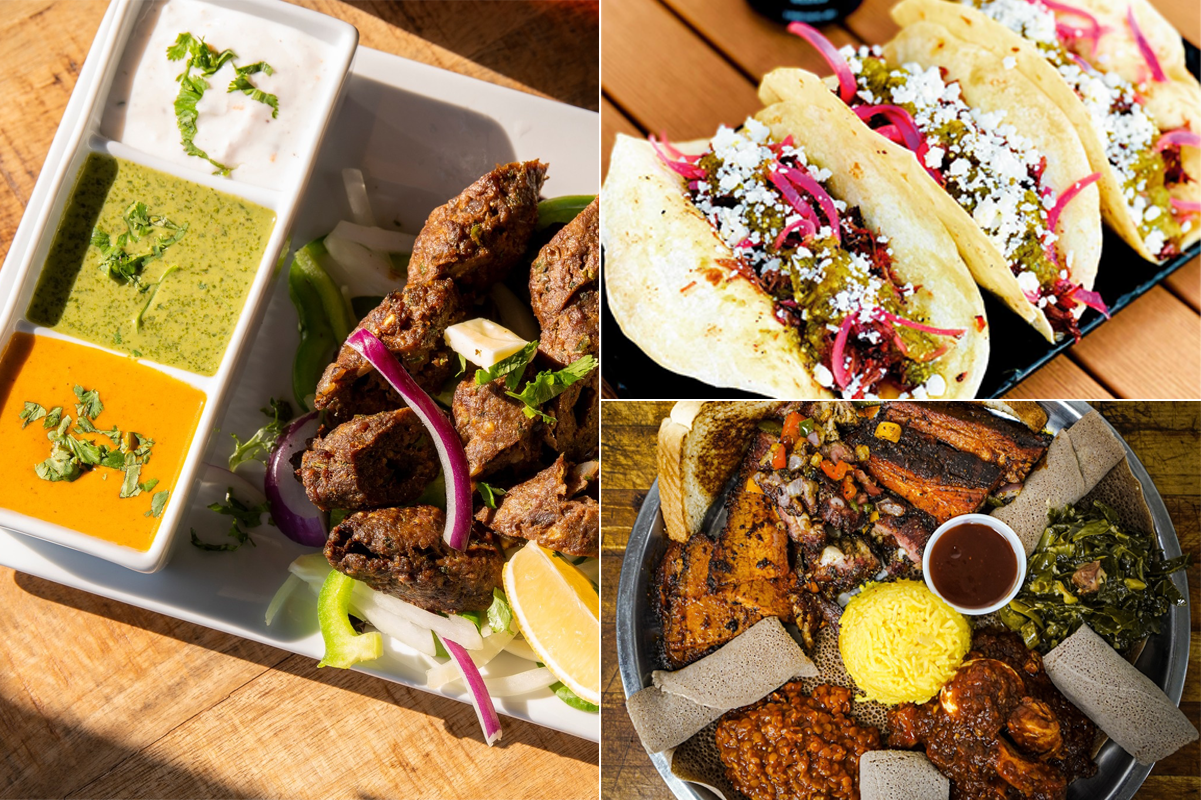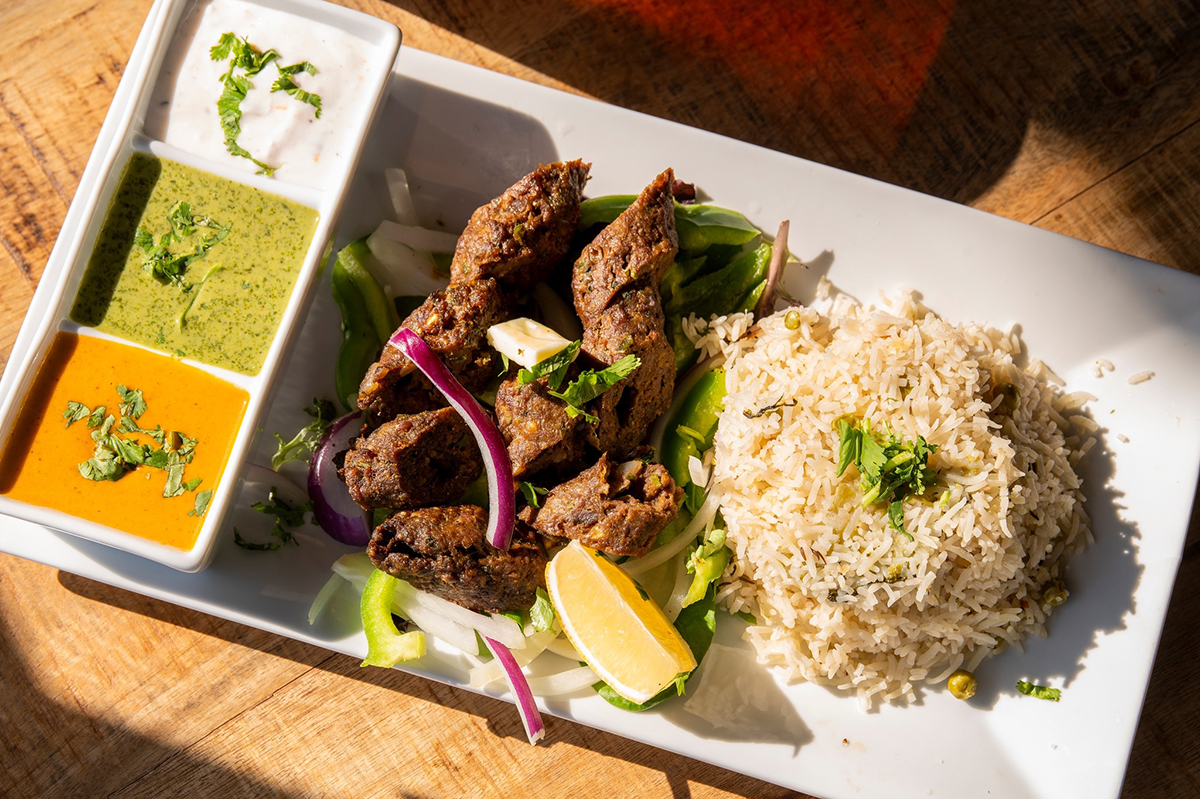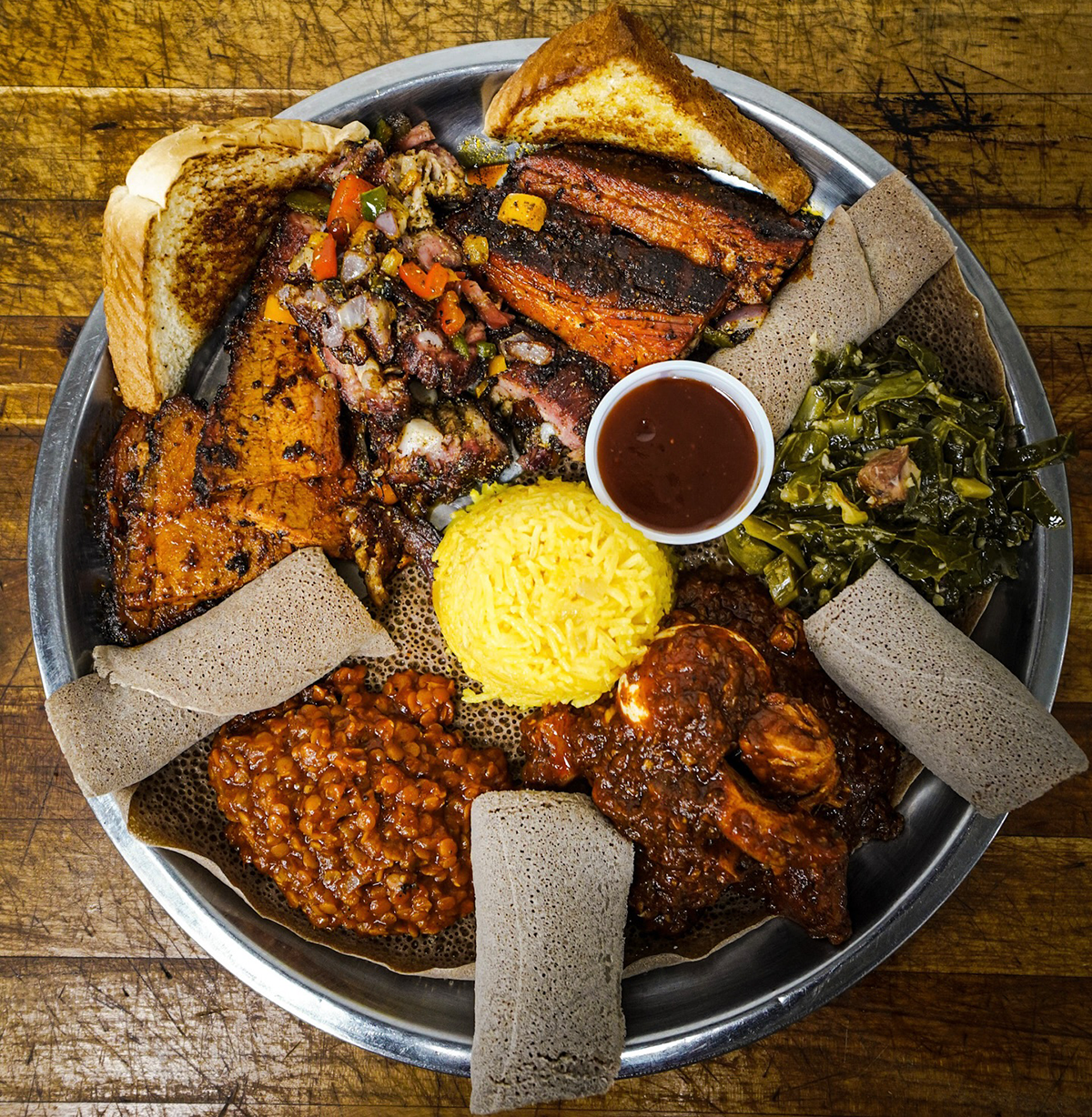
Taking Barbecue Abroad
Where global flavor systems meet American regional traditions
Taking Barbecue Abroad
Where global flavor systems meet American regional traditions
By Rob Corliss
August 16, 2024
By Rob Corliss
August 16, 2024
Barbecue knows no bounds. Already the U.S. culinary landscape boasts a plethora of regional styles and even restaurant-specific variations, but a whole world—literally—of beloved barbecue traditions is waiting to be discovered. With almost every culture boasting a quintessential style, menu developers are beginning to merge global flavors, forms and meat cuts with more domestic styles. And while certain international elements may stray a bit outside the comfort zone for some consumers, barbecue provides a familiar—and craveable—anchor.
There are myriad opportunities for operators to expand menu offerings beyond traditional barbecue boundaries and forge new paths. Here we outline three strategies to apply global stylings and take your barbecue creations to new heights.
1
Meld Regional American Styles with Global Barbecue
 Photo Credit: DJ’s Watering Hole
Photo Credit: DJ’s Watering Hole DJ’s Watering Hole showcases its international flair and selection of smoked meats, including hot links (pictured), in combination plates, which are served with various Indian spices.
Thoughtfully pairing two barbecue styles establishes a premium value-add and piques patron interest through new multicultural flavor experiences rather than passé mash-ups. Menu developers can take one of two approaches. One is to pair a selected American regional barbecue with a trending global barbecue flavor system. Another is to pair a trending global barbecue with an American regional technique or flavor system. Both routes celebrate flavors and tradition. The following flavor destinations offer inspiration in reimagining four classic U.S. regional styles through inventive mergers of ingredients and culinary techniques.
- Kansas City style
- Burnt ends prepared a la Korean barbecue
- Chinese char siu pork tenderloin prepared with thick, sweet and tangy, hoisin-spiked Kansas City-style barbecue sauce
- Texas style
- Central Texas smoked beef brisket (rubbed with guajillo hot sauce, black pepper, salt, garlic powder, achiote) wrapped, smoked, chopped and served on warm white corn tortillas with a dollop of guacamole
- West Texas mesquite fire-kissed Argentine chorizo sausage and top sirloin churrasco flavored with a vibrant South American-inspired Lone Star beer mop sauce, sliced and served atop steak fries
- Memphis style
- Pork ribs seasoned with a Memphis-style barbecue dry rub blended with Middle Eastern spices
- Spicy Mexican slow-smoked pork shoulder chopped and finished with sweet Memphis-style barbecue sauce, served on a sandwich bun with pickled nopales
- Carolinas style
- Grilled Jamaican jerk-rubbed pork shoulder steak doused with South Carolina gold barbecue sauce
- Japanese yakitori or a Southeast Asian satay paired with North Carolina vinegary-thin ketchup barbecue sauce and South Carolina gold barbecue sauce
Menu Sightings
A pairing can be as simple and effective as the Indian-American barbecue combo plates of house-smoked meats topped with masala sauce, at DJ’s Watering Hole in Louisville, Colo.
Kemuri in Austin, Texas, serves up modern Asian barbecue stylings via pork ribs with carrot-ginger glaze, yuzu crema and garlic furikake. The menu also includes beef brisket with Serrano limón-miso barbecue sauce, jalapeño and bread-and-butter pickles.
A’s BBQ in Los Angeles serves Al Pastor Pork Belly Burnt Ends seasoned with a signature al pastor rub and finished with pineapple chunks. Owner Alan Cruz has declared that “even if you’re not a pork belly fan, this will change your mind.”
Curry Boys BBQ in San Antonio specializes in the unique combination of Southeast Asian curry and classic Texas barbecue, all in a rice bowl format. Dig into The Tony Porker that lathers post oak-smoked pulled pork with a bold and flavorful Penang curry.
Buck Tui BBQ in Overland Park, Kan., is invigorating the Kansas City barbecue scene with an injection of northeastern Thai flavor, as exemplified by the Thai-Merican Brisket Sandwich, featuring smoked brisket, papaya slaw, provolone, barbecue sauce and creamy crying tiger sauce.
Smoke Queen Barbecue in Garden Grove, Calif., hits the trend mark with a Mapo Brisket Bowl; slow-smoked burnt ends brisket is simmered in Chinese spices and served with Thai jasmine rice cooked with chicken seasonings and sesame seed oil.
2
Showcase Noteworthy Global Barbecue Culture
 Photo Credit: Smokecraft Modern Barbecue
Photo Credit: Smokecraft Modern Barbecue True to its name, Smokecraft Modern Barbecue brings smoky flavor to multiple components in its barbacoa tacos, including hickory- and oak-smoked beef cheeks, smoked beef tallow flour tortillas and smoked cotija.
Global barbecue culture weaves innumerable threads that span generations. Menu developers can dive deeper into international regions, placing these discoveries front and center to tell an engaging flavor story. South American, Korean, Japanese and Chinese barbecue have already garnered well-deserved attention, but operators wishing to be on the cutting edge can look to other regions for barbecue’s next impactful flavor moments. Below are starter ideas spanning Southeast Asia, the Philippines, Africa, the Middle East and Mexico.
- Southeast Asian satay: skewers with a Vietnamese dry rub (sugar, ginger, coriander, red pepper flakes, sesame, black pepper and lemongrass) or a Thai barbecue sauce (sugar, shallots, Thai chiles, galangal, coriander, makrut lime juice and fish sauce)
- Filipino inihaw: grilled or spit-roasted meats marinated in soy sauce, garlic and calamansi
- West African suya and Ghanaian chichinga: spicy grilled meat skewers with chile, ginger and peanuts
- South African braai: boerewors (coarse ground beef sausage seasoned with coriander, nutmeg, clove and malt vinegar) and sosaties (spicy, sweet and smoky meat and dried apricot kebabs)
- Middle Eastern kebabs: Persian-style koobideh (seasoned with sumac, garlic, turmeric and black pepper) and Levantine shish taouk (with a sauce of yogurt, lemon, tomato paste, paprika, garlic, cinnamon and ginger)
- Mexican barbacoa and cochinita pibil: wrapped in banana leaves and slow cooked with annato seeds, Mexican oregano, orange juice and lime
Menu Sightings
The menu at The Pig and the Lady in Honolulu embraces its mission to cook with Vietnamese sensibilities as showcased by Pho French Dip Banh Mi. The 12-hour slow-roasted beef brisket features spicy hoisin, Thai basil chimichurri, sautéed bean sprouts and onions, cilantro, toasted La Tour baguette and a signature pho broth for dipping.
Inihaw Avenue Filipino Kitchen in Irving, Texas, is a gathering place for authentically grilled Filipino foods like the Inihaw na Liempo, a sliced bone-in pork belly marinated in house-blend spices, grilled and served with pickled papaya slaw.
Distant Relatives in Austin, Texas, celebrates modern African-American cuisine and heightened spice profiles using pecan and mixed hardwood smoke in items like Pulled Pork paired with tamarind molasses barbecue sauce and Chicken Leg Quarters with chile vinegar butter.
Also in Austin, KG BBQ blends the flavors of Egypt and Texas, as exemplified with a signature Sumac and Cinnamon Rubbed Lamb Shoulder, which is smoked, pulled apart and topped with a pistachio-cumin crumble and a side of chimichurri.
Chef Josh Katz’s North African and Mediterranean-inspired grill house, Berber & Q, in London produces live fire-cooked items like Smoked Sticky Lamb Ribs with fermented chile-barbecue sauce and chive yogurt.
The Barbacoa Tacos at Smokecraft Modern Barbecue in Arlington, Va., are loaded with chipotle-cocoa-rubbed beef cheeks that are smoked on oak and hickory and topped with salsa verde, smoked cotija and pickled onions on flour tortillas.
3
Build a “Passport” Barbecue Board
 Photo Credit: Smoke’N Ash
Photo Credit: Smoke’N Ash At Smoke’N Ash, the Tex-Ethiopian Platter blends two flavor systems, bringing Texas barbecue to Ethiopia’s iconic beyaynetu.
Operators can further tempt barbecue enthusiasts and flavor adventurers alike by showcasing shareable Global Barbecue Boards.
Boards of mixed meat and sides are nothing new, but when menu developers inject global flair into the culinary equation, new barbecue flavors jump off the menu. Craft a “Stamp Your Global Q Passport” promotion to showcase international flavor systems, regional specialties and thoughtful combinations of various styles; include sides and condiments from the respective regions. Think of these boards as interactive, tableside theater that capture the spirit of an all-day barbecue affair. The format will also resonate with those who have experienced a South African braai, an Argentinian asado or and an Australian “barbie,” where the lines are delightfully blurred between the barbecue meat and the gathering around it.
Menu Sighting
Smoke’N Ash in Arlington, Texas, brings Ethiopian flavors to the Lone Star tradition. The Tex-Ethiopian Platter is one example featuring smoked doro wat (chicken stew), rib tip tibs, awaze brisket, awaze pork ribs, two sides, Texas toast and choice of injera or rice pilaf.
Barbecue knows no bounds. Already the U.S. culinary landscape boasts a plethora of regional styles and even restaurant-specific variations, but a whole world—literally—of beloved barbecue traditions is waiting to be discovered. With almost every culture boasting a quintessential style, menu developers are beginning to merge global flavors, forms and meat cuts with more domestic styles. And while certain international elements may stray a bit outside the comfort zone for some consumers, barbecue provides a familiar—and craveable—anchor.
There are myriad opportunities for operators to expand menu offerings beyond traditional barbecue boundaries and forge new paths. Here we outline three strategies to apply global stylings and take your barbecue creations to new heights.
1
Meld Regional American Styles with Global Barbecue
 Photo Credit: DJ’s Watering Hole
Photo Credit: DJ’s Watering Hole DJ’s Watering Hole showcases its international flair and selection of smoked meats, including hot links (pictured), in combination plates, which are served with various Indian spices.
Thoughtfully pairing two barbecue styles establishes a premium value-add and piques patron interest through new multicultural flavor experiences rather than passé mash-ups. Menu developers can take one of two approaches. One is to pair a selected American regional barbecue with a trending global barbecue flavor system. Another is to pair a trending global barbecue with an American regional technique or flavor system. Both routes celebrate flavors and tradition. The following flavor destinations offer inspiration in reimagining four classic U.S. regional styles through inventive mergers of ingredients and culinary techniques.
- Kansas City style
- Burnt ends prepared a la Korean barbecue
- Chinese char siu pork tenderloin prepared with thick, sweet and tangy, hoisin-spiked Kansas City-style barbecue sauce
- Texas style
- Central Texas smoked beef brisket (rubbed with guajillo hot sauce, black pepper, salt, garlic powder, achiote) wrapped, smoked, chopped and served on warm white corn tortillas with a dollop of guacamole
- West Texas mesquite fire-kissed Argentine chorizo sausage and top sirloin churrasco flavored with a vibrant South American-inspired Lone Star beer mop sauce, sliced and served atop steak fries
- Memphis style
- Pork ribs seasoned with a Memphis-style barbecue dry rub blended with Middle Eastern spices
- Spicy Mexican slow-smoked pork shoulder chopped and finished with sweet Memphis-style barbecue sauce, served on a sandwich bun with pickled nopales
- Carolinas style
- Grilled Jamaican jerk-rubbed pork shoulder steak doused with South Carolina gold barbecue sauce
- Japanese yakitori or a Southeast Asian satay paired with North Carolina vinegary-thin ketchup barbecue sauce and South Carolina gold barbecue sauce
Menu Sightings
A pairing can be as simple and effective as the Indian-American barbecue combo plates of house-smoked meats topped with masala sauce, at DJ’s Watering Hole in Louisville, Colo.
Kemuri in Austin, Texas, serves up modern Asian barbecue stylings via pork ribs with carrot-ginger glaze, yuzu crema and garlic furikake. The menu also includes beef brisket with Serrano limón-miso barbecue sauce, jalapeño and bread-and-butter pickles.
A’s BBQ in Los Angeles serves Al Pastor Pork Belly Burnt Ends seasoned with a signature al pastor rub and finished with pineapple chunks. Owner Alan Cruz has declared that “even if you’re not a pork belly fan, this will change your mind.”
Curry Boys BBQ in San Antonio specializes in the unique combination of Southeast Asian curry and classic Texas barbecue, all in a rice bowl format. Dig into The Tony Porker that lathers post oak-smoked pulled pork with a bold and flavorful Penang curry.
Buck Tui BBQ in Overland Park, Kan., is invigorating the Kansas City barbecue scene with an injection of northeastern Thai flavor, as exemplified by the Thai-Merican Brisket Sandwich, featuring smoked brisket, papaya slaw, provolone, barbecue sauce and creamy crying tiger sauce.
Smoke Queen Barbecue in Garden Grove, Calif., hits the trend mark with a Mapo Brisket Bowl; slow-smoked burnt ends brisket is simmered in Chinese spices and served with Thai jasmine rice cooked with chicken seasonings and sesame seed oil.
2
Showcase Noteworthy Global Barbecue Culture
 Photo Credit: Smokecraft Modern Barbecue
Photo Credit: Smokecraft Modern Barbecue True to its name, Smokecraft Modern Barbecue brings smoky flavor to multiple components in its barbacoa tacos, including hickory- and oak-smoked beef cheeks, smoked beef tallow flour tortillas and smoked cotija.
Global barbecue culture weaves innumerable threads that span generations. Menu developers can dive deeper into international regions, placing these discoveries front and center to tell an engaging flavor story. South American, Korean, Japanese and Chinese barbecue have already garnered well-deserved attention, but operators wishing to be on the cutting edge can look to other regions for barbecue’s next impactful flavor moments. Below are starter ideas spanning Southeast Asia, the Philippines, Africa, the Middle East and Mexico.
- Southeast Asian satay: skewers with a Vietnamese dry rub (sugar, ginger, coriander, red pepper flakes, sesame, black pepper and lemongrass) or a Thai barbecue sauce (sugar, shallots, Thai chiles, galangal, coriander, makrut lime juice and fish sauce)
- Filipino inihaw: grilled or spit-roasted meats marinated in soy sauce, garlic and calamansi
- West African suya and Ghanaian chichinga: spicy grilled meat skewers with chile, ginger and peanuts
- South African braai: boerewors (coarse ground beef sausage seasoned with coriander, nutmeg, clove and malt vinegar) and sosaties (spicy, sweet and smoky meat and dried apricot kebabs)
- Middle Eastern kebabs: Persian-style koobideh (seasoned with sumac, garlic, turmeric and black pepper) and Levantine shish taouk (with a sauce of yogurt, lemon, tomato paste, paprika, garlic, cinnamon and ginger)
- Mexican barbacoa and cochinita pibil: wrapped in banana leaves and slow cooked with annato seeds, Mexican oregano, orange juice and lime
Menu Sightings
The menu at The Pig and the Lady in Honolulu embraces its mission to cook with Vietnamese sensibilities as showcased by Pho French Dip Banh Mi. The 12-hour slow-roasted beef brisket features spicy hoisin, Thai basil chimichurri, sautéed bean sprouts and onions, cilantro, toasted La Tour baguette and a signature pho broth for dipping.
Inihaw Avenue Filipino Kitchen in Irving, Texas, is a gathering place for authentically grilled Filipino foods like the Inihaw na Liempo, a sliced bone-in pork belly marinated in house-blend spices, grilled and served with pickled papaya slaw.
Distant Relatives in Austin, Texas, celebrates modern African-American cuisine and heightened spice profiles using pecan and mixed hardwood smoke in items like Pulled Pork paired with tamarind molasses barbecue sauce and Chicken Leg Quarters with chile vinegar butter.
Also in Austin, KG BBQ blends the flavors of Egypt and Texas, as exemplified with a signature Sumac and Cinnamon Rubbed Lamb Shoulder, which is smoked, pulled apart and topped with a pistachio-cumin crumble and a side of chimichurri.
Chef Josh Katz’s North African and Mediterranean-inspired grill house, Berber & Q, in London produces live fire-cooked items like Smoked Sticky Lamb Ribs with fermented chile-barbecue sauce and chive yogurt.
The Barbacoa Tacos at Smokecraft Modern Barbecue in Arlington, Va., are loaded with chipotle-cocoa-rubbed beef cheeks that are smoked on oak and hickory and topped with salsa verde, smoked cotija and pickled onions on flour tortillas.
3
Build a “Passport” Barbecue Board
 Photo Credit: Smoke’N Ash
Photo Credit: Smoke’N Ash At Smoke’N Ash, the Tex-Ethiopian Platter blends two flavor systems, bringing Texas barbecue to Ethiopia’s iconic beyaynetu.
Operators can further tempt barbecue enthusiasts and flavor adventurers alike by showcasing shareable Global Barbecue Boards.
Boards of mixed meat and sides are nothing new, but when menu developers inject global flair into the culinary equation, new barbecue flavors jump off the menu. Craft a “Stamp Your Global Q Passport” promotion to showcase international flavor systems, regional specialties and thoughtful combinations of various styles; include sides and condiments from the respective regions. Think of these boards as interactive, tableside theater that capture the spirit of an all-day barbecue affair. The format will also resonate with those who have experienced a South African braai, an Argentinian asado or and an Australian “barbie,” where the lines are delightfully blurred between the barbecue meat and the gathering around it.
Menu Sighting
Smoke’N Ash in Arlington, Texas, brings Ethiopian flavors to the Lone Star tradition. The Tex-Ethiopian Platter is one example featuring smoked doro wat (chicken stew), rib tip tibs, awaze brisket, awaze pork ribs, two sides, Texas toast and choice of injera or rice pilaf.
About the Author
![]() Rob Corliss is a three-time James Beard House guest chef with more than 30 years of experience that includes running world-class hotels, launching new concepts, working in top marketing agencies and owning the culinary consultancy ATE (All Things Epicurean) since 2009. Based in Nixa, Mo., ATE has an energizing passion focused on flavor innovation and is dedicated to connecting people to their food, environment and wellness. Rob is also a regular contributor to Flavor & The Menu.
Rob Corliss is a three-time James Beard House guest chef with more than 30 years of experience that includes running world-class hotels, launching new concepts, working in top marketing agencies and owning the culinary consultancy ATE (All Things Epicurean) since 2009. Based in Nixa, Mo., ATE has an energizing passion focused on flavor innovation and is dedicated to connecting people to their food, environment and wellness. Rob is also a regular contributor to Flavor & The Menu.







